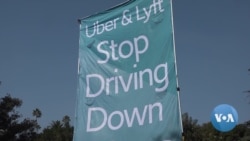Ride share companies such as Uber and Lyft have changed transportation in hundreds of cities around the world, allowing people with vehicles to earn money as drivers and giving commuters an alternative means of travel. But are ride share drivers independent contractors or company employees? The issue is being debated in California, and a new law intended to settle the matter may raise as many questions as it answers.
Increasingly, American companies are cutting their costs by using contractors. The so-called “gig” economy, based on short-term contracts, offers workers flexibility but little job security and fewer benefits. Governor Gavin Newsom signed into law Assembly Bill 5, on Sept. 18, in an effort to clarify an earlier court ruling that imposed strict tests on the classification of workers as employees or contractors. The bill takes effect in January, but its impact remains unclear. Uber and Lyft say that for them, it changes nothing.
Some Uber and Lyft drivers and supporters have held protests throughout the year demanding full benefits, including health insurance and reimbursement for expenses, which they say they would be paid if they classified as company workers.
“We make $100-$200 a day, but when you deduct all the expenses, how much you pay for gas, if you change your oil, how much you pay for your car wash,” there’s not much left, said Uber driver Linda Valdivia.
Contractor vs. employee
Private contractor or employee? The California law has not settled the question for Uber, Lyft or workers in many fields. One driver who works for both ride share companies doesn’t want to be an employee of either.
“It’s going to limit my income, it’s going to limit my freedom on being able to be king of my schedule,” said driver Jack Kinney, who likes things the way they are. “In the last year,” he calculates, “I have spent maybe $1,200 in repair and maintenance on my car. That is less than what I make in a week,” he said.
But the current relationship between driver and company, says a labor analyst, is one-sided and does not meet the test of the new law.
“If you are an independent contractor,” said Saba Waheed, research director of the UCLA Labor Center, “you come into the room, you bring a contract, and then you negotiate the conditions of the work.” With Uber and Lyft drivers, she said, “There is a template, you have to say yes. You can’t get into the (ride share) app.”
The new bill covers not just ride share drivers but workers in many industries.
“It can be a construction worker, it can be a nail salon worker, janitors, (or) other more professional skills,” Waheed explained.
Exemptions to law
Some occupations were granted exemptions to the law, including doctors and lawyers. Also exempt are hair stylists, insurance agents, commercial fishermen and others. Worried truckers, who want to stay independent, also want an exemption. Restaurants that rely on internet-based delivery services say it will hurt business.
David Nelson of the CalAsian Chamber of Commerce works with thousands of Asian American businesses in California, many of them own restaurants.
“A brick and mortar (business) that’s actively engaging to expand their business through technology, and that needs to be supported and protected at all costs,” he said.
“We support the benefits the drivers are asking for,” said Nelson, but with the rollout of the law, “it quickly became apparent that this is a really big catch-all,” with unintended consequences, he said.
Uber and Lyft say that forcing their drivers into a traditional job structure hurts drivers.
“That limits their flexibility, and we know from research that at least 75 percent of these drivers want to remain flexible,” said Stacey Wells of the Coalition to Protect App-Based Drivers & Services, a ballot initiative drive sponsored by Uber, Lyft and the food delivery company DoorDash. They are spending $30 million each to promote a compromise measure, to be decided by the voters. It would offer a guaranteed base wage and other benefits, including a health care subsidy, and provide better screening and training for drivers to address growing safety concerns.
Critics say the proposal contains too many loopholes. Drivers would not be paid for waiting times between passenger trips, for example.
New York law
In response to driver protests, New York enacted a law effective last February that guarantees drivers more than $17 an hour plus payments for distance. It was based on recommendations from University of California, Berkeley economist Michael Reich and a colleague.
“We’ve seen that the driver pay has gone up since that time,” said Reich, adding, “The companies are now limiting the number of new drivers into the system, and fares aren’t that different from what they were before.”
He says the new law has reduced congestion and pollution in New York and “aligns the interests of the drivers and the company much more, and the public.”
Uber driver Jack Kinney doesn’t want to see changes that will limit his flexibility. “I’ve spent more time with my family since I started working ride share than when I was working a regular job because I can command my own schedule, just show up when things are needed,” he said.
Uber driver Linda Valdivia supports an organizing effort by the Service Employees International Union, one of the groups that has sponsored driver protests. She said momentum is on the side of the activists.
“We have politicians, we have our union all over the country with us, so we’ve been winning at each step of the way,” she said.
In California and other places, both sides say the issues surrounding the growing “gig” economy will be resolved through negotiation, fine-tuning local and state laws, challenges in court and at the ballot box.










